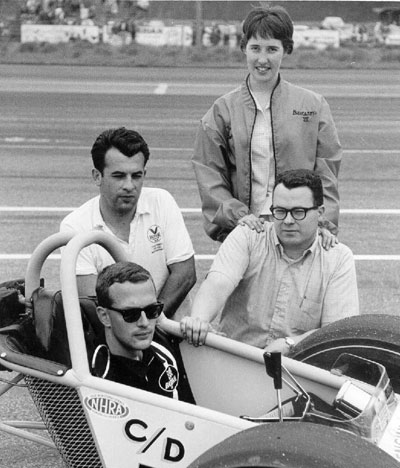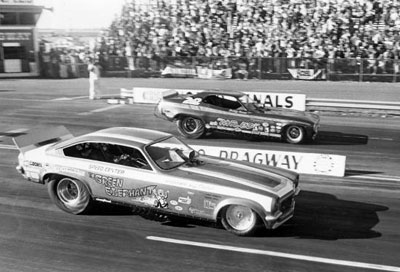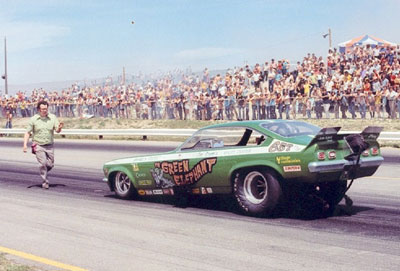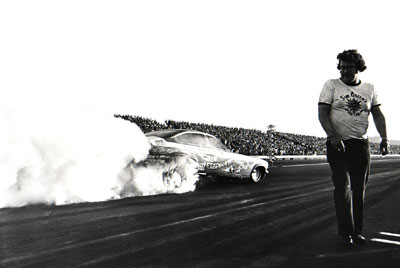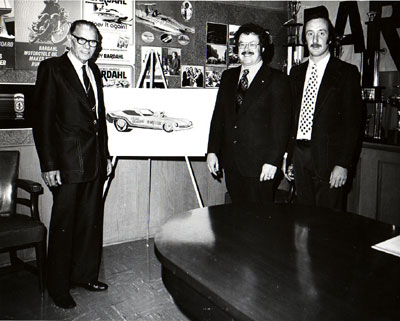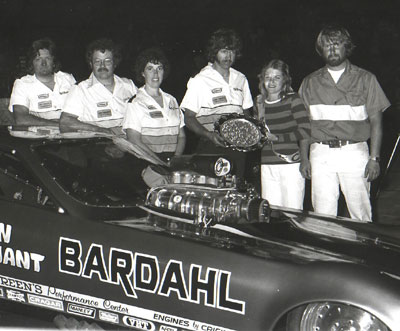

One of Funny Car's original mean, green machines
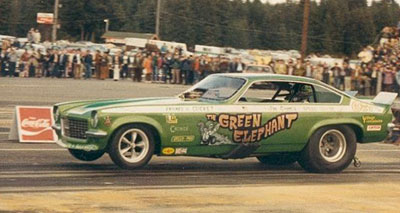 |
|
|
|
|
Back in the day, there were three things considered bad luck at the auto races. The first was having women in the pits. Well, obviously that’s now changed; some drag racing forefathers are probably rolling in their final firesuits to see women not only in the pits but in the winners circle.
Second was eating peanuts. I’m not sure how or why this one ever got started, but it got exorcised a while ago
The third was a taboo against anything green in the pits, which I’m pretty sure that John Force’s all-conquering green and white Castrol cars have put to rest once and for all.
But before Force ever turned a tire in his ol’ Castrol heap, another green machine was tearing up the quarter-mile: Jim Green’s “Green Elephant” Funny Car. It may well have been the first green car to win an NHRA world championship.
I heard recently from Jim’s wife, Betty, who shared with me some of the history of the powerful pachyderm. The couple, who still reside in Bothell Wash., met some 45 years ago and she instantly became “a drag racer and an avid drag race fan.”
By that time, Green had campaigned numerous cars, including a '39 Chevy and the B-Boys Special B/Dragster at California tracks such Cotati (near Sonoma), Fremont, Pomona, and even at Indy in 1962. The B-Boys name came from the Seattle auto parts store where Green worked beginning in 1956 and a decade later he opened his own speed shop, Jim Green’s Speed Center (later known as Jim Green’s Performance Center) in Lynnwood, Wash., which he still operates. Betty says that even though he has tried to retire, he still works at the store, sometimes six days a week.
After getting out of drag racing, Green tried his hand at tractor pulling, built street rods, and, most recently, was instrumental in the restoration of the Jim Crooke’s Assassination AA/FD, buying, with Crooke, the car, and supplying the Ford cammer engine. (Check out Crooke’s tale of the restoration here, on Don Ewald’s We Did It For Love site.)
“I started going to the races with Jim just after he built his Jiminy Cricket Special B/Dragster the winter of 1962-63,” Betty recalls. “When she saw that we were serious, his mother handed me an empty scrapbook and a box of photos and clippings. I put together that first album and I had a career from then on. In the years that followed I faithfully recorded Jim's racing life, from the ‘50s through the ‘70s, his pulling life in the ‘80s and ‘90s, and life with the Assassin in the 21st Century, as well as his street rodding over all the decades. I still have albums of clippings and photos ongoing.”
“Jim was a good teacher and he welcomed my questions and then my help. I became a hands-on crew member, sometimes the only one in the early years. We raced from Pomona, Calif., to Edmonton, Alberta, at tracks like Arlington, Pacific Raceways, Firebird Raceway in Boise, at Mission, Calgary, Bremerton, Shelton, Woodburn, and Portland. We were weekend warriors, and, as true drag racers do today, we loved it.”
They ran their B/Dragster for several years, collecting national records, a Division 6 championship, and, after Green decided in 1967 that he’d rather tune than drive, the 1968 NHRA World Championship in Comp with Ray Hadford driving.
The Greens bought their first Funny Car, a Vega, from Joe Pisano in early 1972 and named it the Green Elephant, then had a new Don Long Vega built in 1973. Hadford initially drove the car in 1972 and won the presitgious Seafair 64 Funny Car race, but left the team early in 1973 to tend to his sick father, and was replaced by Frank Hall.
I asked Betty about the so-called green jinx, and she recalled Jim telling her stories of guys he knew who sit in their garage using lacquer thinner to scrub the green lettering off their hoses. “But Green was our name,” she said, “and there were Pink Elephants and Black Elephants [so-called because the new 426 Hemi engine was called the “elephant” and built by either Keith Black or Ed Pink], so calling our car the Green Elephant was too good a thing to pass up. Jim's employees at the shop came up with the idea and we all worked hard to talk him into using it. He was a little reluctant, but came around.”
|
|
|
|
|
|
|
|
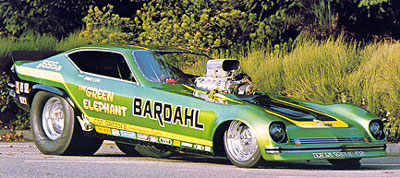 |
|
|
Jerry Verhuel, who would gain national fame for his efforts a few years later with “240 Gordie” Bonin, was listed the team’s crew chief, but, like Force’s Austin Coil and Bernie Fedderly, he and Green were co-crew chiefs, according to Betty. With Hall at the wheel, they won the 1973 Division 6 Funny Car Championship and the 1973 NHRA Funny Car World Championship, the Greens’ second world title. Hall secured the title with a holeshot victory in the final round at the World Finals in Amarillo –when winning the event decided the season champion – defeating Bobby Rowe and the Mr. Ed Satellite, 6.39 to 6.38.
In the summer of ‘74, Hall moved on to handle Jerry Ruth's Mustang Funny Car and Mike Miller took over the controls of the green machine. He was runner-up at the ‘75 NHRA Winternationals when the car broke on the line against Don Prudhomme. After sitting out the 1976 season, the Greens returned to competition with sponsorship from Bardahl. Mike Cyr, who later would buy the Green’s equipment, took Betty’s scrapbooks and left them with Ole Bardahl's daughter, Evelyn Manchester. She liked what she saw and talked her father into sponsoring the team. Cyr initially was slated to drive but it didn’t work out, and future Top Fuel world champ Rob Bruins in the saddle of a new slant-nosed Vega. Veteran nitro wheelman Norm Wilcox also drove the car and Richard Rodgers took the car to runner-up at the ‘77 U.S. Nationals, again to Prudhomme. Prudhomme had qualified his Army-sponsored Plymouth Arrow No. 1 with a 6.06 and ran 6.14, 6.10, 6.13, and a final-round 6.24 to defeat Rogers, who had qualified with a 6.21 and hit a best of 6.31 in eliminations but slowed to a 6.58 in the final after losing traction.
“Bardahl was planning to sponsor us for three years, but after the first year, even though they were impressed with our appearances and the numbers on the reports I sent every week, they decided to go to TV game shows instead,” remembers Betty. “We were very sad. They were so good to us and we loved working with them. Their people were jobbers who drove to all the gas stations, tire stores and small repair shops. We made many appearances for them and met so many nice people.
“Without Bardahl we could not afford to race. It was not a full sponsorship so we were still putting our own money in the car. So when they pulled out, we had to pull out, too. It was a hard decision to make.
“We raced all over the U.S. and Canada in 1973, 1974, 1975 .and 1977,” remembers Betty. “We have often talked of writing about our ‘road stories’ during those years, traveling from track to track: of transmissions and rear ends, of trying to sleep in the back seat of the crew cab pickup, of driving through snow and on icy roads, of my driving straight through from Seattle to Edmonton when everyone else on the crew was suffering from the flu, of spending time waiting for parts, of my Indiana speeding ticket when we were trying to get to Indy before Tech closed (we were confronted by a huge trooper who demanded instant payment and we thought he was asking for a bribe. We forgot that Indiana was not on Daylight Saving Time so we still made it with minutes to spare.), of climbing the fence at Indy so we could get in line to run, and then changing pistons and even a motor in the staging lanes.”
As the cost of fuel racing continued to rise, Green turned to other outlets for his creativity. He spent three years building the ’34 Ford Phaeton had been dreaming of building for many years, which was chock full of drag racing influences, including a hydraulically operated tilt body that gave easy access to the ’67 Ford Cammer motor. They called the car The Phunny Phaeton and it was featured in several car magazines in1982.
Green so loved the Cammer that he began collecting them and at one time owned 19 of the rare engines. Some of which went into his street rods, some to customers, and, of course, they were the source of power for tractor pullers, which included a ’69 Ford pickup in the four-wheel drive class and a Funny Car puller. His pride and joy, though, was a triple-engine tractor they called Shotgun, fitted with three 604-cid Ford Boss 429 motors.
It was only natural then that his love of the Cammer played a role in the Assassin restoration. The Greens had attended the 2001 NHRA California Hot Rod Reunion and, after seeing the wonderful restored cars in the Cacklefest, Jim decided he wanted to find a Top Fuel car that had run a Cammer motor. After searching through old records, they discovered that Crooke, another veteran of Northwest racing, not only had campaigned a cammer-powered dragster back in the ;60s but knew where the old car was.
“Jim bought the car and he and Jim Crooke worked together to restore it,’ said Betty. “It was a huge very expensive job, but the car which was beautiful originally, is now exactly like it was then. They were very proud of the car. It was restored to its May 1968 configuration. Jim continues to show the car, fires the motor for many car events, and does exhibition push starts at drag races. He tows it behind his 1967 Pontiac station wagon and uses the wagon for push starts. We have had several guest drivers besides Rob, including Bob Muravez and good friend Eric Medlen.
“We loved the people, especially, and still have long-time friendships with racers and their families, many of whom are still racing today. I especially loved being a woman in what some call a man's world and was lucky to be part of that world. I had so many others to admire: Alison Lee, Shirley Muldowney, Mary Ann Method, Kim LaHaie, Diane Dunn, Shelly Payne, Melanie, Angelle, Hillary, and Ashley (you go, girl!!). There are so many more and I admire them all.
“I love the guys, too. I have many male friends from our drag racing days: Gordie Bonin, Twig Zeigler, Jerry Ruth, Steve Gibbs, Bernie Fedderly. I am an avid John Force fan (is there anyone in the world who does not love him?) and by extension, his family and anyone who drives for him. I root for T.J. and Del and Gary Scelzi and Gary Densham and Doug Kalitta and J.R. and Larry and Whit (hope he comes back soon) and Brandon and … oh, shoot, I love them all. It has been wonderful watching the young people grow and mature and become the veterans of the sport.”
Jim Green's contributions to Northwest drag racing werenlt forgotten either. In 2005, he was named to the Division 6 Hall of Fame, an honor well deserved after two decades of turning some of the best of the northwest, well, green with envy.





















































